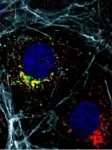(Press-News.org) New research uncovers substantial differences in rates of childhood cancers when considering single year of age rather than grouping several years together. The study published by Wiley early online in CANCER, a peer-reviewed journal of the American Cancer Society, also found that minority children have different risks than white children for many types of cancer.
Cancer rates among children in the United States are typically reported in 5-year age groups, which may obscure important details. Also, racial and ethnic variations in pediatric cancer rates are typically presented in broad age categories.
Erin L. Marcotte, PhD, of the University of Minnesota, and her colleagues examined 2000-2017 data from the Surveillance, Epidemiology, and End Results (SEER) Program, a source for cancer statistics in the United States, to assess cancer incidence rates by narrow age groups from birth to 39 years and across races and ethnicities. "There are significant racial and ethnic disparities in the incidence of some childhood cancer types," said Dr. Marcotte. Additionally, unlike in cancers that occur in older adults, the incidence of cancer among children and young adults has striking variations by age at diagnosis, and studying these variations has often led to a deeper understanding of causes of childhood cancer."
Several cancer types showed substantial differences by single year of age, both overall and across racial and ethnic groups. Black children, adolescents and young adults had lower rates of acute lymphoblastic leukemia, or ALL (a white blood cell cancer), compared with white children, especially at ages 1 through 7 years and 16 through 20 years. "Black children and young adults had lower rates of ALL, the most common childhood leukemia, at every age, but this decreased risk was most striking among children ages 2 to 5, where the ALL incidence among Black children was less than half that of white children," said Dr. Marcotte.
The researchers also observed that while Black children experienced the same incidence of non-Hodgkin lymphoma (another white blood cell cancer) as white children, Black young adults were at higher risk than white young adults, beginning at age 28. Black children were also at higher risk for nephroblastoma, a rare kidney tumor typically diagnosed before age 5 years.
Hispanic children had higher risk of Hodgkin lymphoma than white children at ages 0 to 9 years, but had lower risk at all other ages. They also had lower rates of astrocytoma, a cancer of the brain or spinal cord, but higher rates of ALL, especially at ages 10 through 23 years. The analysis also revealed that Asian and Pacific Islanders and American Indian and Alaskan Natives have lower rates of many types of childhood cancer.
"Some of the patterns we observed may be due to racial and ethnic differences in known childhood cancer risk factors, such as exposure to infections and congenital anomalies," said Dr. Marcotte. "We also know that the causes of each type of childhood and young adult cancer may vary depending on the age at which it occurs. For instance, exposure to Epstein-Barr virus is associated with Hodgkin lymphoma diagnosed in children younger than age 10, but not at older ages. Thus Epstein-Barr virus exposure may explain the higher risk of Hodgkin lymphoma among Hispanic children younger than age 10."
Dr. Marcotte hopes that this work will play a role in reducing racial and ethnic disparities in cancer risk among children and young adults.
INFORMATION:
Additional Information
NOTE: The information contained in this release is protected by copyright. Please include journal attribution in all coverage. A free abstract of this article will be available via the Cancer News Room upon online publication. For more information or to obtain a PDF of any study, please contact:
Dawn Peters +1 781-388-8408 (US)
newsroom@wiley.com
Follow us on Twitter @WileyNews
Full Citation:
"Racial and ethnic disparities in pediatric cancer incidence among children and young adults in the United States by single year of age." Erin L. Marcotte, Allison M. Domingues, Jeannette M. Sample, Michaela R. Richardson, and Logan G. Spector. CANCER; Published Online: June 21, 2021 (DOI: 10.1002/cncr.33678).
URL Upon Publication: http://doi.wiley.com/10.1002/cncr.33678
Author Contact: Max Huber, at mjhuber@umn.edu, or Jessica Alkire at jalkire@umn.edu.
About the Journal
CANCER is a peer-reviewed publication of the American Cancer Society integrating scientific information from worldwide sources for all oncologic specialties. The objective of CANCER is to provide an interdisciplinary forum for the exchange of information among oncologic disciplines concerned with the etiology, course, and treatment of human cancer. CANCER is published on behalf of the American Cancer Society by Wiley and can be accessed online.
Follow us on Twitter @JournalCancer
About Wiley
Wiley is a global leader in research and education, unlocking human potential by enabling discovery, powering education, and shaping workforces. For over 200 years, Wiley has fueled the world's knowledge ecosystem. Today, our high-impact content, platforms, and services help researchers, learners, institutions, and corporations achieve their goals in an ever-changing world. Visit us at Wiley.com, like us on Facebook and follow us on Twitter and LinkedIn.
When a University of Michigan-led research team reported last year that North American migratory birds have been getting smaller over the past four decades and that their wings have gotten a bit longer, the scientists wondered if they were seeing the fingerprint of earlier spring migrations.
Multiple studies have demonstrated that birds are migrating earlier in the spring as the world warms. Perhaps the evolutionary pressure to migrate faster and arrive at breeding grounds earlier led to the physical changes the U-M-led team observed.
"We know that bird morphology has a major effect on the efficiency and speed of flight, so we became curious whether the environmental ...
University of Maryland School of Medicine (UMSOM) researchers identified a new gene that may be linked to certain neurodevelopmental disorders and intellectual disabilities. The researchers believe that finding genes involved in certain types of developmental disorders, provide an important first step in determining the cause of these disorders and ultimately in developing potential therapies for treating them. The paper was recently published in the American Journal of Human Genetics.
About 3 percent of the world's population has intellectual disability. Up to half the cases are due to genetics, however, because many thousands of genes contribute to brain development, it has been difficult to identify the specific cause for each patient.
Once the researchers ...
People who struggle with social anxiety might experience increased distress related to mask-wearing during and even after the COVID-19 pandemic.
A paper authored by researchers from the University of Waterloo's Department of Psychology and Centre for Mental Health Research and Treatment also has implications for those who haven't necessarily suffered from social anxiety in the past.
"The adverse effects of the COVID-19 pandemic on mental health outcomes, including anxiety and depression, have been well-documented," said David Moscovitch, professor of clinical psychology and co-author of the paper. "However, little is known about effects of increased mask-wearing on social interactions, social anxiety, or overall mental health.
"It is also possible ...
Pseudomonas aeruginosa is an opportunistic pathogenic bacterium present in many ecological niches, such as plant roots, stagnant water or even the pipes of our homes. Naturally very versatile, it can cause acute and chronic infections that are potentially fatal for people with weakened immune systems. The presence of P. aeruginosa in clinical settings, where it can colonise respirators and catheters, is a serious threat. In addition, its adaptability and resistance to many antibiotics make infections by P. aeruginosa increasingly difficult to treat. There is therefore an urgent need to develop new antibacterials. Scientists from the University of Geneva (UNIGE), Switzerland, ...
(Vienna, Monday, 21 June, 2021) COVID-19 patients suffer from cognitive and behavioural problems two months after being discharged from hospital, a new study presented at the 7th Congress of the European Academy of Neurology (EAN) has found.
Issues with memory, spatial awareness and information processing problems were identified as possible overhangs from the virus in post-COVID-19 patients who were followed up within eight weeks.
The research also found that one in 5 patients reported post-traumatic stress disorder (PTSD), with 16% presenting depressive symptoms. ...
The first global standards to embed health and wellbeing into the education system have been created amid a rise in mental health problems during the COVID-19 pandemic.
Researchers at the Centre for Adolescent Health at the Murdoch Children's Research Institute (MCRI) led the two-year project at the invitation of the World Health Organization (WHO) and the United Nations Educational, Scientific and Cultural Organization (UNESCO). The two reports, to be launched this week in Geneva, provide a benchmarking framework to support the implementation of 'health promoting schools,' which aim to equally foster health ...
Washington, DC - June 20, 2021 - Researchers from Yonsei University in South Korea have found that certain commensal bacteria that reside in the human intestine produce compounds that inhibit SARS-CoV-2. The research will be presented on June 20 at World Microbe Forum, an online meeting of the American Society for Microbiology (ASM), the Federation of European Microbiological Societies (FEMS), and several other societies that will take place online June 20-24.
Previous clinical findings have shown that some patients with moderate to severe COVID-19 have gastro-intestinal symptoms, while others showed signs of infection solely in the lungs.
"We wondered whether gut ...
Washington, D.C. - June 20, 2021 - Increased screen time among young adults during the COVID-19 pandemic correlated with a rise in pandemic-related distress, according to research led by investigators at the Saint James School of Medicine on the Caribbean island nation, Saint Vincent. The increase in time spent viewing entertainment on a screen both prior to and during the pandemic was associated with a boost in anxiety scores. Students scored higher than non-students in pandemic-related distress. Surprisingly, the results showed no association of depression with screen ...
Washington, DC - June 20, 2021 - Researchers from the Miami University in Ohio have optimized a new technique that will allow scientists to evaluate how potential inhibitors work on antibiotic-resistant bacteria. This technique, called native state mass spectrometry, provides a quick way for scientists to identify the best candidates for effective clinical drugs, particularly in cases where bacteria can no longer be treated with antibiotics alone. This research will be presented at the American Society for Microbiology World Microbe Forum online conference on June 21, 2021.
Overuse of antibiotics in the last century has led to a rise in bacterial resistance, leading to many bacterial infections that are no longer treatable with current antibiotics. In the United States each year, 2.8 million ...
Washington, D.C. - June 20, 2021 - Although two SARS-CoV-2 variants are associated with higher transmission, patients with these variants show no evidence of higher viral loads in their upper respiratory tracts compared to the control group, a Johns Hopkins School of Medicine study found.
The emergence and higher transmission of the evolving variants of SARS-CoV-2, the virus that causes COVID-19, has been concerning. The researchers investigated B.1.1.7, the variant first identified in the UK, and B.1.351, the variant first identified in South Africa, to evaluate if patients showed higher ...


